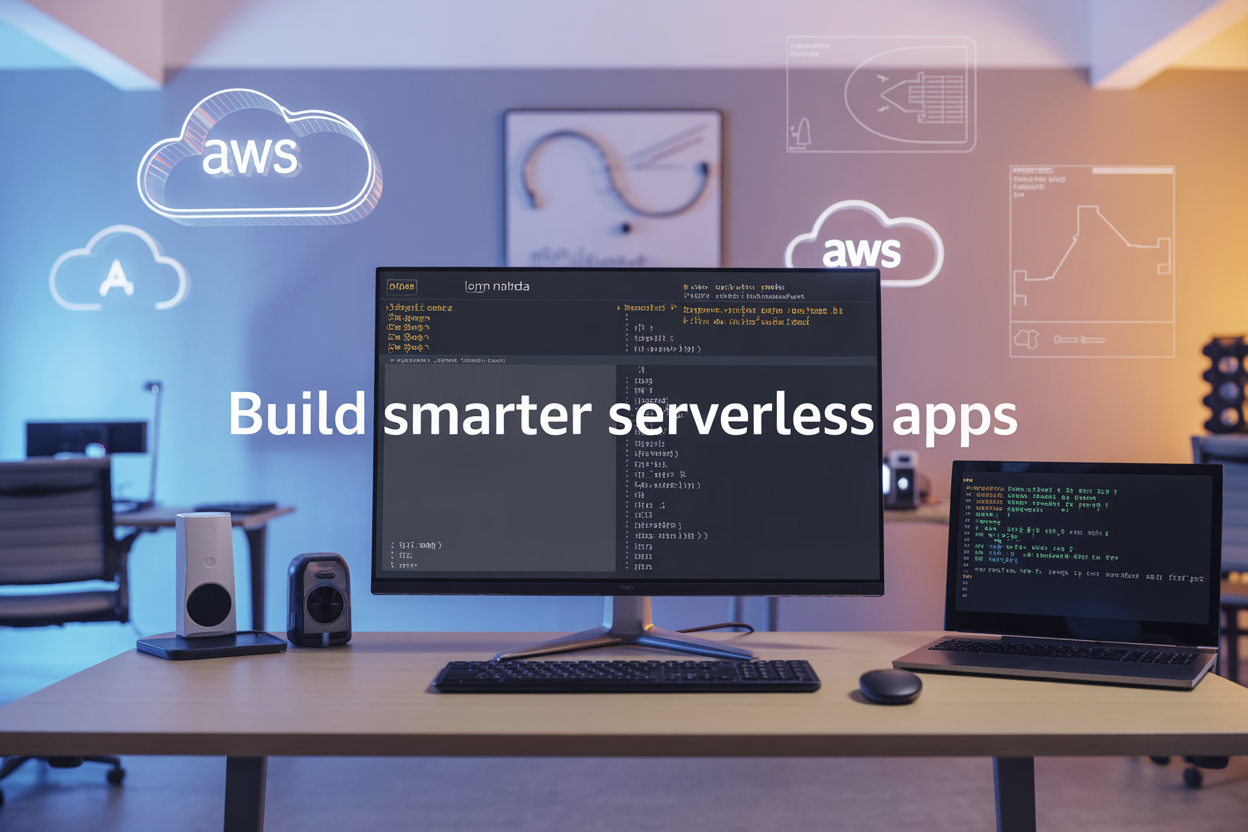Poor Lambda naming and disorganized serverless architecture can turn your AWS applications into an expensive, unmaintainable mess. This guide shows software engineers, DevOps teams, and cloud architects how to implement AWS Lambda best practices that prevent chaos and create serverless applications that actually scale.
You’ll discover proven serverless naming conventions that make your functions instantly recognizable across teams and projects. We’ll explore scalable architecture patterns for Lambda function organization that keep your codebase clean as it grows. Finally, you’ll learn practical cost optimization and security standards that protect your serverless deployment practices from common pitfalls that drain budgets and expose vulnerabilities.
Essential Lambda Naming Conventions That Prevent Chaos

Function Names That Communicate Purpose and Environment
Creating clear, descriptive function names saves countless hours of debugging and prevents deployment disasters. Your Lambda function names should instantly communicate three key pieces of information: what the function does, which service it belongs to, and which environment it’s running in.
Start with a consistent naming pattern like {service}-{environment}-{function-purpose}. For example, user-management-prod-create-user or payment-processing-dev-process-refund. This approach makes it impossible to accidentally deploy development code to production or wonder what a function does six months later.
Environment indicators prevent the classic mistake of updating the wrong function during urgent fixes. Use consistent environment abbreviations: dev, staging, prod, test. Avoid creative variations like development or production that break your pattern.
Service prefixes group related functions together in the AWS console, making navigation intuitive. When your team has dozens of Lambda functions, being able to quickly identify all payment-related functions or user management functions becomes invaluable.
Function purpose should be specific enough to understand the action but concise enough to stay readable. Instead of process-data, use validate-customer-data or transform-order-data. The extra specificity pays dividends when troubleshooting production issues at 2 AM.
Resource Tags That Enable Cost Tracking and Management
Resource tags transform your AWS bill from a mysterious black box into actionable cost intelligence. Without proper tagging, you’ll struggle to answer basic questions like “How much does our authentication service cost?” or “Which team’s Lambda functions are driving up our compute costs?”
Implement mandatory tags for every Lambda function: Environment, Service, Team, CostCenter, and Project. These tags should mirror your organization’s structure and budgeting needs. The Environment tag helps separate development costs from production costs, while Service tags enable accurate cost allocation per business function.
Create a tagging strategy that includes both technical and business context. Technical tags like Version, DeploymentMethod, and Runtime help with operational decisions. Business tags like BusinessUnit, Customer, and Feature enable accurate chargeback and ROI calculations.
| Tag Name | Purpose | Example Values |
|---|---|---|
| Environment | Deployment stage | dev, staging, prod |
| Service | Business function | user-auth, payment, notification |
| Team | Responsible team | platform-team, mobile-team |
| CostCenter | Budget allocation | engineering, marketing, operations |
Automate tag enforcement through AWS Config rules or Infrastructure as Code templates. Manual tagging leads to inconsistent data that undermines cost tracking efforts. Most importantly, regularly audit your tags and update them as your organization evolves.
IAM Role Naming Patterns for Security and Compliance
IAM role names directly impact security audits and compliance reporting. A well-named role immediately communicates its purpose, scope, and permissions level. Poor naming leads to permission creep and makes security reviews nearly impossible.
Follow the pattern {service}-{environment}-{function-type}-{permission-level} for Lambda execution roles. For example, user-service-prod-api-read-only or payment-processor-dev-background-full-access. This naming convention makes it easy to identify overprivileged roles during security reviews.
Permission levels should be explicit: read-only, write-only, full-access, or custom. Avoid generic terms like basic or standard that don’t communicate actual capabilities. When auditors ask about data access patterns, your role names should provide immediate clarity.
Create separate roles for different function types even within the same service. API functions typically need different permissions than background processing functions. Database migration functions need broader access than regular CRUD operations. This separation makes security boundaries explicit and reduces blast radius when permissions need to change.
Document role inheritance and cross-service access patterns. When payment-service-prod-api-read-only needs to access user data, create a specific cross-service role rather than expanding existing permissions. This approach maintains clear audit trails and makes permission changes predictable.
Environment Variable Standards for Configuration Management
Environment variables often contain your application’s most sensitive data and critical configuration. Inconsistent naming and poor organization create security vulnerabilities and deployment failures.
Use SCREAMING_SNAKE_CASE for all environment variable names and group them with consistent prefixes. Database configuration might use DB_HOST, DB_PORT, DB_NAME while external service configuration uses API_PAYMENT_URL, API_NOTIFICATION_KEY. This grouping makes configuration reviews easier and reduces naming conflicts.
Distinguish between different types of configuration data through prefixes. Use SECRET_ for sensitive data that should be encrypted, CONFIG_ for application settings, and FEATURE_ for feature flags. This naming convention makes it obvious which variables need extra security attention.
| Variable Type | Prefix | Example |
|---|---|---|
| Database Config | DB_ |
DB_CONNECTION_POOL_SIZE |
| External APIs | API_ |
API_STRIPE_WEBHOOK_SECRET |
| Feature Flags | FEATURE_ |
FEATURE_ADVANCED_ANALYTICS |
| Secrets | SECRET_ |
SECRET_JWT_SIGNING_KEY |
Standardize environment-specific variable handling. Development environments might use DEV_DB_HOST while production uses PROD_DB_HOST, or you might use the same variable names with different values per environment. Choose one approach and stick to it across all functions to prevent configuration mix-ups.
Never hardcode environment-specific values in variable names like PRODUCTION_DATABASE_URL. Instead, use consistent names like DATABASE_URL and manage values through your deployment pipeline. This approach makes promoting code between environments predictable and reduces configuration drift.
Scalable Architecture Patterns for Lambda Function Organization

Monolithic vs Microfunction Approaches for Different Use Cases
When building serverless applications with AWS Lambda, choosing between monolithic and microfunction approaches directly impacts your serverless architecture patterns and long-term scalability. Each approach serves different business needs and technical requirements.
Monolithic Lambda Functions work best for tightly coupled business logic where operations naturally flow together. Consider an e-commerce order processing function that validates payment, updates inventory, and sends confirmation emails. Bundling these operations into a single Lambda reduces cold start latency and simplifies transaction management. This approach shines when you need consistent performance and have predictable traffic patterns.
Microfunction Architecture excels when you need independent scaling and deployment of discrete operations. Breaking that same e-commerce flow into separate functions—payment validation, inventory management, and notification services—allows each component to scale based on demand. Payment processing might need higher memory allocation, while notifications can run on minimal resources.
| Aspect | Monolithic Functions | Microfunctions |
|---|---|---|
| Cold Start Impact | Lower frequency | Higher per operation |
| Development Complexity | Simpler initially | Higher coordination overhead |
| Scaling Granularity | All-or-nothing | Per-function optimization |
| Testing Isolation | More complex mocking | Independent unit tests |
| Resource Utilization | May over-provision | Right-sized per function |
Choose monolithic functions for CRUD operations, data processing pipelines, and workflows with strong consistency requirements. Opt for microfunctions when building event-driven systems, API gateways with diverse endpoints, or applications requiring different runtime environments.
Shared Layer Strategies That Reduce Bundle Size
Lambda layers revolutionize how you manage dependencies across your serverless functions, dramatically improving Lambda function organization and reducing deployment times. Strategic layer implementation can cut bundle sizes by 60-80% while maintaining clean separation of concerns.
Runtime Dependencies Layer should contain your heaviest dependencies like AWS SDK extensions, database drivers, and third-party libraries. Create a base layer with commonly used packages across your application. For Node.js applications, this might include lodash, moment, and AWS SDK v3 clients. Python applications benefit from layers containing pandas, requests, and boto3 extensions.
Shared Business Logic Layer houses utility functions, configuration managers, and common business rules used across multiple functions. This prevents code duplication and ensures consistency in error handling, logging, and validation logic. Keep this layer lightweight and focused on pure functions without external dependencies.
Environment-Specific Configuration Layer manages environment variables, connection strings, and feature flags. This approach allows you to deploy the same function code across development, staging, and production while maintaining different configurations through layers.
Layer Structure Example:
├── runtime-dependencies-layer (50MB)
├── business-logic-layer (2MB)
├── config-layer (1MB)
└── function-code (5MB)
Version your layers strategically. Create new versions only when breaking changes occur, not for every deployment. This prevents cascading updates across functions and maintains deployment stability. Use layer permissions to control access across AWS accounts and maintain security boundaries.
Event-Driven Design Patterns That Handle Growth
Building robust serverless applications requires event-driven design patterns that naturally accommodate growth without architectural rewrites. These patterns leverage AWS Lambda’s event-driven nature while ensuring your application remains responsive under varying loads.
Fan-Out Pattern distributes single events to multiple downstream functions, perfect for scenarios like user registration triggering account creation, welcome emails, and analytics tracking. Use Amazon SNS or EventBridge to broadcast events, allowing each consuming function to process independently. This pattern prevents single points of failure and enables parallel processing.
Saga Pattern manages complex, multi-step workflows by breaking them into discrete, compensatable transactions. When processing large data imports, create separate functions for validation, transformation, and storage. Each step publishes success or failure events, with compensation logic handling rollbacks. This approach provides fault tolerance and maintains data consistency across distributed operations.
Circuit Breaker Pattern protects your Lambda functions from cascading failures when calling external services. Implement state tracking in DynamoDB to monitor failure rates and automatically fail fast when downstream services become unavailable. This prevents resource waste and improves user experience by providing immediate feedback.
Dead Letter Queue Pattern ensures no events get lost during processing failures. Configure DLQs for all event sources and implement separate functions to analyze and reprocess failed events. This pattern becomes critical as your application grows and handles more diverse event types.
Batch Processing Pattern optimizes cost and performance for high-volume operations. Instead of processing individual records, accumulate events in SQS or Kinesis and process them in batches. Configure batch sizes based on your function’s memory and timeout limits to maximize throughput while staying within AWS Lambda performance optimization guidelines.
These patterns work together to create resilient serverless architecture patterns that handle traffic spikes, service failures, and evolving business requirements without requiring fundamental changes to your application structure.
Performance Optimization Techniques for Production Lambda Functions

Memory and Timeout Configuration Best Practices
Getting your AWS Lambda performance optimization right starts with smart memory and timeout settings. Most developers stick with the default 128 MB memory allocation, but this often leads to slower execution and higher costs. Memory directly affects CPU power in Lambda – more memory means more processing speed.
Start by benchmarking your functions with different memory configurations. Use AWS X-Ray or CloudWatch Insights to measure execution duration across various memory settings. You’ll often find a sweet spot where increasing memory reduces execution time enough to offset the higher per-millisecond cost.
For timeout settings, avoid the temptation to set maximum values as a safety net. Long timeouts can mask underlying performance issues and create unpredictable costs. Set timeouts based on your 99th percentile execution times plus a reasonable buffer. Monitor timeout errors closely – they often signal inefficient code or resource bottlenecks.
| Memory (MB) | CPU Power | Use Case |
|---|---|---|
| 128-512 | Low | Simple API responses, basic processing |
| 1024-2048 | Medium | Data transformations, image processing |
| 3008+ | High | Machine learning inference, heavy computations |
Cold Start Reduction Strategies That Improve User Experience
Cold starts can make or break user experience in serverless applications. These delays happen when AWS creates new execution environments for your functions. While you can’t eliminate cold starts entirely, smart strategies dramatically reduce their impact.
Keep your deployment packages lean. Remove unnecessary dependencies, use AWS Lambda Layers for shared libraries, and consider tree-shaking for JavaScript applications. Smaller packages mean faster initialization times.
Provisioned Concurrency eliminates cold starts for predictable traffic patterns. Set it up for functions handling user-facing requests where milliseconds matter. Monitor your concurrency metrics to find the right balance between cost and performance.
Connection pooling outside the handler function helps maintain database connections across invocations. This prevents the overhead of establishing new connections on every request while reducing cold start penalties.
Consider implementing function warming through scheduled CloudWatch Events for critical functions. A simple ping every few minutes keeps instances warm, though this adds operational complexity and costs.
Language choice significantly impacts cold start performance:
- Python and Node.js: Fastest cold starts, ideal for latency-sensitive applications
- Java and C#: Longer initialization but better sustained performance
- Go: Good balance of cold start speed and execution performance
Connection Pooling and Resource Reuse Methods
Database connections are expensive to establish and often become performance bottlenecks in serverless applications. Smart connection management separates high-performing Lambda functions from sluggish ones.
Initialize database connections outside your handler function. This keeps connections alive between invocations within the same execution environment. For relational databases, use connection pooling libraries that handle connection lifecycle automatically.
RDS Proxy solves many connection management headaches for AWS Lambda serverless applications. It maintains a pool of database connections and automatically handles scaling, reducing the connection overhead that often slows down functions.
// Good: Connection outside handler
const mysql = require('mysql2/promise');
const pool = mysql.createPool({
host: process.env.DB_HOST,
user: process.env.DB_USER,
password: process.env.DB_PASSWORD,
database: process.env.DB_NAME,
connectionLimit: 1
});
exports.handler = async (event) => {
const connection = await pool.getConnection();
// Use connection
connection.release();
};
HTTP connections benefit from similar treatment. Reuse HTTP clients and enable keep-alive connections to external APIs. This reduces the TCP handshake overhead that adds latency to every external call.
Cache frequently accessed data in global variables or use ElastiCache for shared caching across function instances. Just remember that Lambda containers aren’t permanent – build fallback logic for cache misses.
Monitoring Metrics That Matter for Performance Tracking
Effective AWS Lambda performance optimization requires monitoring the right metrics. CloudWatch provides dozens of metrics, but focusing on key indicators prevents analysis paralysis.
Duration metrics tell the complete performance story. Track average, maximum, and 99th percentile execution times. Sudden spikes often indicate resource constraints or downstream service issues.
Error rates and throttles reveal scaling problems before they impact users. Set up alarms for error rates above 1% and any throttling events. These metrics help identify when you need to increase reserved concurrency or optimize function logic.
Memory utilization shows whether your functions are over or under-provisioned. Lambda bills by memory allocated, not used, so right-sizing saves money. Use the max memory used metric to optimize your allocation.
Concurrent executions help predict scaling patterns and potential throttling. Monitor this alongside error rates to understand capacity constraints.
| Metric | Good Threshold | Action Required |
|---|---|---|
| Duration > p99 | < 2x average | Investigate performance bottlenecks |
| Error Rate | < 0.1% | Check function logic and dependencies |
| Throttles | 0 | Increase reserved concurrency |
| Memory Utilization | 60-80% | Adjust memory allocation |
Custom metrics provide deeper insights into business logic performance. Track database query times, external API response times, and business-specific operations. CloudWatch custom metrics integrate seamlessly with Lambda functions through the AWS SDK.
Set up CloudWatch dashboards that combine infrastructure and application metrics. This holistic view helps identify correlations between system performance and business outcomes, making performance optimization more strategic and impactful.
Security and Access Control Standards for Lambda Deployments

Least Privilege IAM Policies That Protect Your Resources
Creating bulletproof IAM policies starts with giving your Lambda functions only the permissions they actually need. Most developers fall into the trap of copying overly broad policies from tutorials or granting excessive permissions to avoid debugging access issues. This approach creates massive security holes.
Start by identifying exactly what AWS services your Lambda function needs to interact with. If your function only reads from a specific S3 bucket, don’t give it access to all S3 buckets or write permissions it doesn’t need. Create custom IAM policies that specify the exact resources using ARNs rather than wildcards.
Here’s a practical approach to building secure IAM policies:
| Permission Type | Bad Practice | Best Practice |
|---|---|---|
| S3 Access | s3:* on * |
s3:GetObject on arn:aws:s3:::my-bucket/* |
| DynamoDB | dynamodb:* |
dynamodb:PutItem, dynamodb:GetItem on specific table |
| Logging | Full CloudWatch access | logs:CreateLogGroup, logs:CreateLogStream, logs:PutLogEvents |
Use AWS IAM Policy Simulator to test your policies before deployment. This tool helps you understand exactly what your Lambda function can and cannot do, preventing both security vulnerabilities and permission-related runtime errors. Regular policy auditing becomes essential as your application evolves – what started as a simple data processing function might grow into something that needs additional permissions.
Consider implementing resource-based policies alongside identity-based policies for defense in depth. This dual approach ensures that even if one layer fails, your resources remain protected.
VPC Configuration Guidelines for Network Security
VPC configuration for Lambda functions requires careful planning to balance security with performance. When you place Lambda functions inside a VPC, they lose internet access by default, which means you need to plan your network architecture thoughtfully.
Create dedicated subnets for your Lambda functions, separate from your EC2 instances or databases. This segmentation allows you to apply specific security group rules and network ACLs that match your Lambda security requirements. Private subnets work best for most Lambda use cases since these functions rarely need direct internet access.
Your Lambda functions need internet connectivity for AWS service calls unless you’re using VPC endpoints. Set up NAT gateways in public subnets to provide outbound internet access for functions in private subnets. While this adds cost, it’s essential for functions that need to call AWS APIs or external services.
Configure VPC endpoints for frequently used AWS services like S3, DynamoDB, and Parameter Store. These endpoints keep traffic within AWS’s network, improving both security and performance while reducing NAT gateway costs. The initial setup takes time, but the long-term benefits in terms of security and cost savings make it worthwhile.
Security groups act as virtual firewalls for your Lambda functions. Create specific security groups that only allow the traffic your functions actually need. For example, if your Lambda function connects to an RDS database, create a security group that only allows outbound traffic on the database port to the database’s security group.
Monitor VPC flow logs to understand your Lambda function’s network behavior and identify any unusual traffic patterns that might indicate security issues.
Environment Variable Encryption and Secret Management
Environment variables in Lambda functions store configuration data, but they shouldn’t store sensitive information like API keys, database passwords, or encryption keys in plain text. AWS provides built-in encryption for environment variables using AWS KMS, but the real magic happens when you combine this with proper secret management practices.
Enable encryption for environment variables using either AWS managed keys or your own KMS keys. Customer-managed keys give you more control over access policies and audit trails, which becomes crucial for compliance requirements. Set up key rotation policies to automatically update encryption keys on a regular schedule.
AWS Systems Manager Parameter Store and AWS Secrets Manager offer better alternatives for truly sensitive data. These services provide automatic rotation, fine-grained access control, and detailed audit logs that environment variables can’t match.
Parameter Store Approach:
- Store non-secret configuration in standard parameters
- Use SecureString parameters for sensitive data
- Implement parameter hierarchies like
/app-name/environment/parameter-name - Cache parameters in your Lambda function to reduce API calls
Secrets Manager Integration:
- Store database credentials, API keys, and certificates
- Enable automatic rotation for supported services
- Use versioning to handle rotation gracefully
- Implement proper error handling for secret retrieval failures
Your Lambda function code should retrieve secrets at runtime rather than storing them in environment variables. Implement caching to avoid excessive API calls to Parameter Store or Secrets Manager, but set appropriate TTL values to ensure your function gets updated secrets when they rotate.
Create separate secrets for different environments (development, staging, production) and use consistent naming conventions that make it easy for your team to manage secrets across multiple applications.
API Gateway Integration Security Measures
API Gateway serves as the front door to your Lambda functions, making its security configuration critical for protecting your entire serverless application. Start with proper authentication and authorization mechanisms that match your application’s security requirements.
Implement API keys for basic client identification, but don’t rely on them alone for security. API keys work well for rate limiting and usage tracking, but they’re not sufficient for protecting sensitive data. Combine API keys with more robust authentication methods like JWT tokens, OAuth 2.0, or AWS Cognito integration.
Configure request validation at the API Gateway level to reject malformed requests before they reach your Lambda functions. This approach reduces compute costs and provides an additional security layer by filtering out potential attack vectors early in the request lifecycle.
Essential API Gateway Security Settings:
- Enable AWS WAF integration to protect against common web exploits
- Configure rate limiting and throttling to prevent abuse
- Set up CORS policies that only allow requests from authorized domains
- Enable detailed logging and monitoring for security analysis
- Implement request/response size limits to prevent resource exhaustion
Use Lambda authorizers for complex authorization logic that goes beyond simple API key validation. These custom authorizers can integrate with your existing identity providers, perform complex business logic validation, and cache authorization decisions to improve performance.
Enable API Gateway caching carefully, ensuring that sensitive data doesn’t get cached inappropriately. Configure cache key parameters to prevent unauthorized access to cached responses and set appropriate TTL values that balance performance with data freshness requirements.
Consider implementing IP whitelisting for internal APIs or adding geographic restrictions for applications that serve specific regions. These controls add another layer of protection against unauthorized access attempts.
Deployment and CI/CD Practices That Scale With Your Team

Infrastructure as Code Templates for Consistent Deployments
Building reliable serverless deployment practices starts with Infrastructure as Code (IaC) templates that eliminate the guesswork from Lambda deployments. AWS CloudFormation and AWS SAM (Serverless Application Model) serve as your foundation for creating repeatable, version-controlled infrastructure deployments.
Start with SAM templates that define your Lambda functions alongside their dependencies, API Gateway configurations, and IAM roles. This approach ensures every deployment creates identical environments, whether you’re pushing to development, staging, or production. Your SAM template should include parameterized values for different environments, allowing you to maintain a single source of truth while adapting to specific environment needs.
# Example SAM template structure
AWSTemplateFormatVersion: '2010-09-09'
Transform: AWS::Serverless-2016-10-31
Parameters:
Environment:
Type: String
AllowedValues: [dev, staging, prod]
Resources:
MyLambdaFunction:
Type: AWS::Serverless::Function
Properties:
FunctionName: !Sub "${Environment}-my-service-handler"
Runtime: nodejs18.x
CodeUri: src/
Handler: index.handler
Terraform offers another powerful option for managing Lambda infrastructure, especially when you’re working with multi-cloud deployments or complex AWS ecosystems. The key advantage lies in Terraform’s state management and its ability to handle intricate resource dependencies across different AWS services.
Create modular IaC templates that separate concerns – one module for Lambda functions, another for API Gateway, and separate modules for databases and monitoring. This modular approach makes your AWS Lambda CI/CD pipeline more maintainable and allows different teams to work on different components without stepping on each other’s toes.
Blue-Green Deployment Strategies for Zero-Downtime Updates
Blue-green deployments represent the gold standard for serverless deployment practices that minimize risk while maximizing availability. AWS Lambda aliases and weighted routing make implementing this strategy straightforward and cost-effective.
Set up your Lambda function with two aliases: “blue” for your current production version and “green” for your new deployment. Start by deploying your updated code to a new version, then point the green alias to this version. Test thoroughly using the green alias endpoint before switching any production traffic.
Lambda’s weighted alias feature lets you gradually shift traffic from blue to green. Begin with 10% of traffic going to the new version, monitor your CloudWatch metrics for errors or performance issues, then incrementally increase the percentage. If problems arise, you can instantly route all traffic back to the blue version.
# AWS CLI commands for weighted deployment
aws lambda update-alias \
--function-name my-function \
--name green \
--function-version 5 \
--routing-config AdditionalVersionWeights={"4"=0.9,"5"=0.1}
API Gateway stages work hand-in-hand with Lambda aliases for end-to-end blue-green deployments. Create separate stages that point to your blue and green aliases, allowing you to test the entire request flow before switching production traffic.
CodeDeploy integrates seamlessly with Lambda for automated blue-green deployments. Configure deployment configurations that automatically handle the traffic shifting based on CloudWatch alarms. If your error rate exceeds predefined thresholds or response times degrade, CodeDeploy automatically rolls back to the previous version.
Monitor key metrics during deployments: error rates, duration, memory usage, and concurrent executions. Set up CloudWatch alarms that trigger automatic rollbacks when these metrics exceed acceptable thresholds. This automated safety net ensures your deployments maintain high availability even when human operators aren’t actively monitoring.
Automated Testing Frameworks for Lambda Functions
Comprehensive testing forms the backbone of reliable serverless application scaling. Lambda functions require different testing approaches compared to traditional server-based applications, focusing on event-driven testing, integration testing with AWS services, and performance testing under various load conditions.
Unit testing Lambda functions starts with separating your business logic from the Lambda handler. Create pure functions that can be tested independently of AWS services, then test the handler separately. Use mocking libraries like AWS SDK mocks or Sinon.js to simulate AWS service calls without incurring costs or dependencies on actual AWS resources.
// Example testable Lambda structure
const { processOrder, handler } = require('./orderProcessor');
const AWS = require('aws-sdk');
// Testable business logic
async function processOrder(orderData) {
// Pure business logic here
return processedOrder;
}
// Lambda handler
exports.handler = async (event) => {
const orderData = JSON.parse(event.body);
const result = await processOrder(orderData);
// AWS service interactions here
return { statusCode: 200, body: JSON.stringify(result) };
};
Integration testing validates your Lambda functions work correctly with other AWS services. Use localstack or AWS SAM local for running integration tests in your CI pipeline without hitting production AWS services. These tools simulate AWS services locally, allowing you to test DynamoDB interactions, S3 operations, and SNS/SQS messaging without incurring costs.
Load testing Lambda functions requires special consideration for cold starts and concurrent execution limits. Use artillery.io or similar tools to simulate realistic traffic patterns. Test both cold start performance and sustained load scenarios to understand how your functions behave under different conditions.
Implement contract testing for Lambda functions that serve as APIs. Tools like Pact or AWS’s own API testing capabilities help ensure your Lambda functions maintain consistent interfaces even as internal implementations change. This becomes critical when multiple teams depend on your Lambda functions.
Set up automated testing pipelines that run different test suites at appropriate stages: unit tests on every commit, integration tests on pull requests, and load tests on deployments to staging environments. This layered approach catches different types of issues at the most cost-effective points in your development cycle.
Version Control and Rollback Procedures
Effective version control for Lambda functions goes beyond just storing code in Git. Your AWS Lambda CI/CD pipeline needs robust versioning that tracks both code changes and infrastructure modifications, enabling quick rollbacks when issues arise.
Lambda’s built-in versioning system creates immutable snapshots of your function code and configuration. Each deployment should create a new version, never overwrite existing versions. Use semantic versioning tags in your Git repository that correspond to Lambda versions, creating a clear audit trail from code commits to deployed functions.
# Example versioning strategy
git tag -a v1.2.3 -m "Release version 1.2.3"
git push origin v1.2.3
# Deploy with version tracking
sam deploy --parameter-overrides Version=v1.2.3
Implement automated rollback triggers based on CloudWatch metrics. Configure CodeDeploy or custom Lambda functions to automatically revert to previous versions when error rates spike or response times degrade beyond acceptable thresholds. This automated approach reduces mean time to recovery and minimizes the impact of problematic deployments.
Maintain deployment manifests that capture the complete state of your Lambda environment for each release. Include function versions, environment variables, IAM role ARNs, and dependency versions. Store these manifests in version control alongside your code, enabling you to recreate any previous deployment state exactly.
Create rollback runbooks that document the specific steps for reverting different types of changes. Simple code rollbacks might only require updating an alias, while infrastructure changes might need full CloudFormation stack updates. Train your team on these procedures and test rollback processes regularly during non-peak hours.
Use feature flags within your Lambda functions to enable quick rollbacks of specific functionality without full deployments. This approach allows you to disable problematic features instantly while maintaining overall service availability. Combine feature flags with monitoring to automatically disable features that exceed error thresholds.
Cost Management Strategies for Large-Scale Lambda Applications

Right-Sizing Functions to Optimize Compute Costs
Memory configuration directly impacts your AWS Lambda costs, making it the most critical lever for Lambda cost optimization. Each function’s memory allocation determines both RAM availability and CPU power, with pricing scaling linearly from 128MB to 10,240MB.
Start by analyzing your function’s actual memory usage through CloudWatch metrics. The maximum memory used metric reveals whether you’re over-provisioning resources. Functions using only 60% of allocated memory present immediate optimization opportunities.
Memory Optimization Guidelines:
| Function Type | Recommended Memory | Use Case |
|---|---|---|
| Simple API responses | 128-256MB | Basic CRUD operations |
| Data processing | 512-1024MB | JSON manipulation, validations |
| File operations | 1024-3008MB | Image processing, document parsing |
| ML inference | 3008MB+ | Model predictions, heavy computations |
CPU-bound workloads benefit from higher memory allocations despite not needing the RAM. Lambda allocates CPU proportionally to memory, so a function processing large datasets might run faster and cheaper at 1024MB than 512MB due to reduced execution time.
Monitor your duration and memory metrics weekly. Functions consistently finishing under 100ms might benefit from memory reduction, while those approaching timeout limits need performance analysis before memory adjustments.
Reserved Concurrency Settings That Control Spending
Reserved concurrency acts as your primary cost control mechanism, preventing runaway executions from generating unexpected bills. This feature guarantees specific concurrency levels for critical functions while capping maximum simultaneous executions.
Configure reserved concurrency based on your traffic patterns and downstream system capabilities. A function processing database writes shouldn’t exceed your RDS connection pool limits, regardless of incoming request volume. Setting concurrency to 50 for a function connecting to a database with 100 connection limits provides safety margins.
Concurrency Planning Strategy:
- Critical functions: Reserve 20-30% of account concurrency limit
- Background processing: Limit to prevent resource starvation
- Webhook handlers: Match expected peak traffic with 25% buffer
- Scheduled functions: Reserve minimal concurrency (1-5)
Provisioned concurrency addresses cold start latency but significantly increases costs. Use it sparingly for user-facing APIs requiring sub-100ms response times. Monitor provisioned concurrency utilization; unused provisioned capacity wastes money.
Account-level concurrency limits default to 1000 in most regions. Large-scale applications should request limit increases early, as AWS reviews can take several days. Document your capacity planning with traffic projections and current usage patterns.
Dead Letter Queue Implementation for Error Handling
Dead letter queues (DLQ) prevent costly retry loops while preserving failed messages for analysis. Without proper error handling, functions can consume significant compute time processing invalid data repeatedly.
Configure DLQs for all asynchronous Lambda invocations, including S3 events, SNS triggers, and SQS processing. Failed messages land in designated queues instead of disappearing, enabling debugging and reprocessing without losing data.
DLQ Configuration Best Practices:
# Terraform example
resource "aws_sqs_queue" "lambda_dlq" {
name = "${var.function_name}-dlq"
message_retention_seconds = 1209600 # 14 days
visibility_timeout_seconds = 300
}
Set maximum retry attempts to 2-3 for most use cases. Higher retry counts increase costs without improving success rates for persistent failures. Transient errors typically resolve within the first few attempts.
Implement DLQ monitoring through CloudWatch alarms. Messages appearing in dead letter queues indicate systemic issues requiring immediate attention. Create alerts when DLQ depth exceeds zero, triggering investigation workflows.
Process DLQ messages during maintenance windows using dedicated functions with higher memory allocations. These processing functions can implement enhanced logging, alternative processing paths, or manual intervention triggers for complex failure scenarios.
Regular DLQ cleanup prevents storage costs from accumulating. Archive messages older than 30 days to S3 for compliance requirements while removing them from active queues. Automated cleanup functions running weekly maintain optimal queue sizes and costs.

Following consistent naming conventions and organizing your Lambda functions properly sets the foundation for everything else. When your functions are well-named and structured, debugging becomes easier, team collaboration improves, and scaling your application feels natural rather than overwhelming. The performance optimizations, security measures, and cost management strategies we covered work best when built on top of this solid organizational foundation.
Start with the naming standards and architecture patterns first – these decisions are harder to change later when you have dozens or hundreds of functions running. Then layer in the performance tweaks, security controls, and cost monitoring as your application grows. Your future self and your teammates will thank you for taking the time to build things right from the beginning, and your AWS bills will stay manageable even as your serverless footprint expands.




















